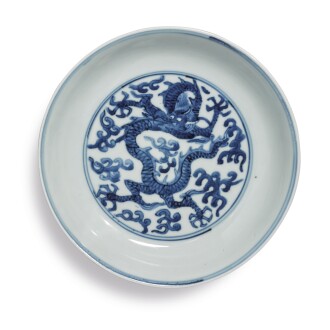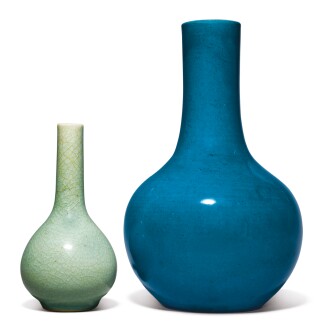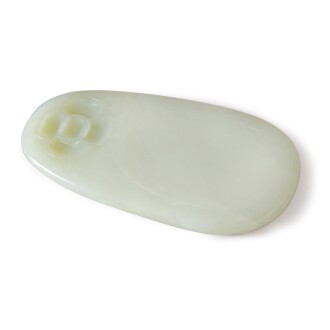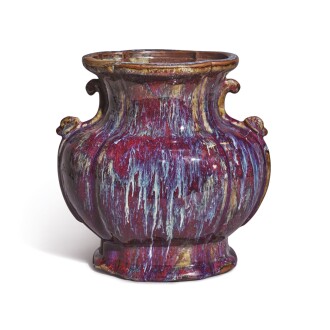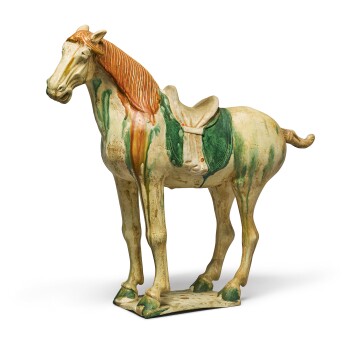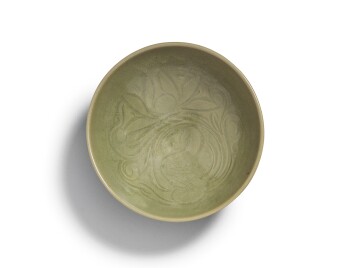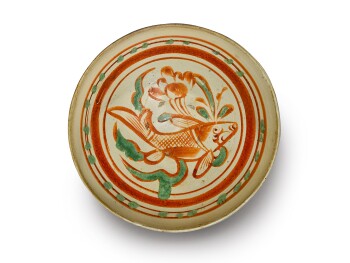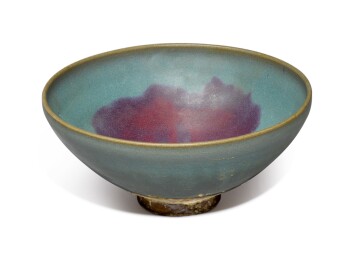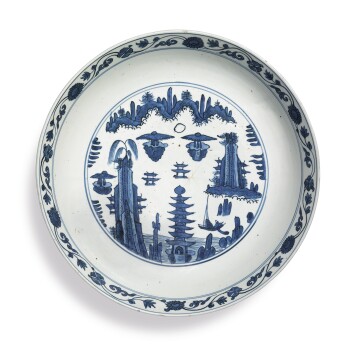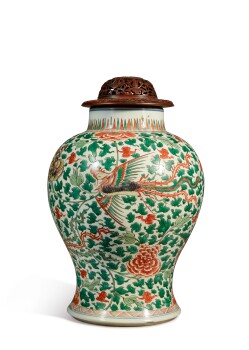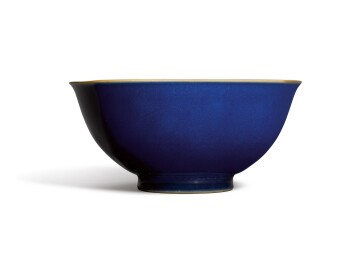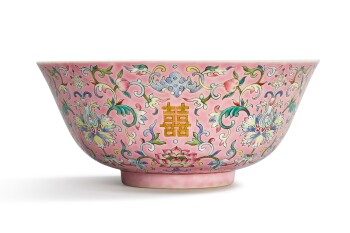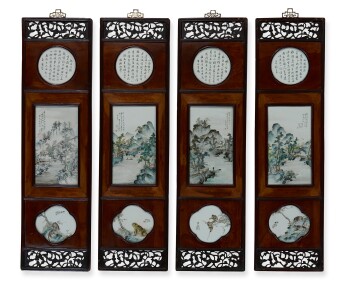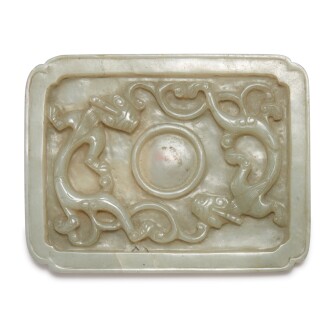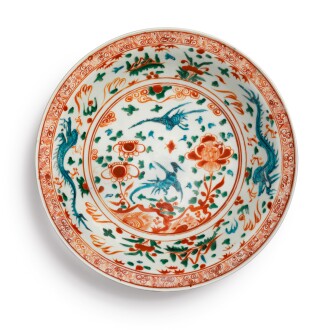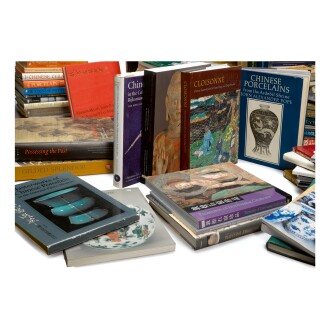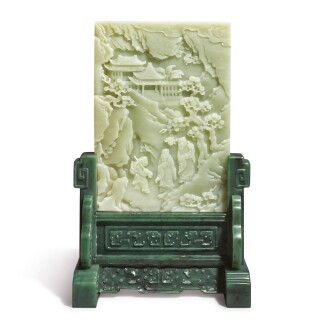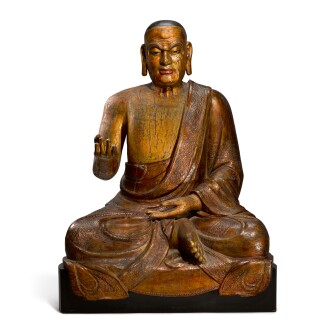F ormerly known as Saturday at Sotheby’s: Asian Art, The Hundred Antiques: Fine & Decorative Asian Art comprises over 290 lots of Chinese, Japanese, Indian, Himalayan and Southeast Asian works of art and paintings. The sale features Ming and Qing porcelain, furniture, scholar’s objects, a group of Chinese jades and hardstone carvings from the collection of William Boyce Thompson (1869-1930) and Indian and Himalayan works of art from the collection of Mr. and Mrs. Paul E. Manheim.


Further highlights include a set of four famille-rose panels signed Duan Zian, an imperial late Qing dynasty twelve-symbol ‘dragon’ robe, a Jin dynasty Cizhou bowl formerly in the Linyushanren Collection, and a Tang dynasty sancai-glazed horse formerly from Warren E. Cox and the collection Lillian Schloss.
Sale Highlights
The Hundred Antiques
‘The Hundred Antiques’ is a Chinese decorative pattern that became popular in the 17th century and is commonly found in the arts of the Qing dynasty (1644–1911). Objects within this pattern can include antique bronzes, ceramics, scholar’s objects, and other three-dimensional decorative arts, and were often incorporated into auspicious rebuses. Many works of art in this sale are real life examples of what might be found in the pattern. Click on the hotspots on a jardinière decorated with the ‘Hundred Antiques’ to discover some examples.

- A Black-Glazed Rouleau Vase
- An Archaistic ‘Hongmu’ Corner-Leg Table
- A Famille-Verte ‘Floral’ Rouleau Vase
- A Painted and Turquoise-Glazed ‘Cizhou’ Meiping
- Two Dehua Square Stands
- An Aubergine-Ground ‘Three Abundances’ Alms Bowl

The clean, austere lines of hardwood furniture, strikingly spare monochromatic vessels, patinas on treasured organic surfaces, or coalescing glaze effects on a splashed vessel point to an emphasis on pure line, form, texture, and color—tenets of Chinese art that also appeal to prevailing contemporary tastes.

Color, luster, tactility—these are all qualities prized in glazes utilized in Chinese ceramic glazes. Ranging from the dappled jeweled hues found on Tang dynasty sancai wares, delicately nuanced stonewares of the Song period, to painterly blue and white Ming period vessels and exuberant Qing famille-rose and famille-verte porcelains, the sale offers a condensed look into the breadth and depth of Chinese glazed ceramics from the Tang period onwards.

William Boyce Thompson (1869-1930) was an influential mining baron, financier, political insider, and philanthropist during the turn of the 20th century. Believing that sustainable agriculture and food supply were critical for global stability and human welfare, he established the Boyce Thompson Institute for Plant Research in Yonkers, New York, which continues to make major contributions in the field. Thompson’s lifelong interest in the natural world led him to amass a fine collection of carved gems and stones, a portion of which was willed to the American Museum of Natural History in New York. The present selection of Chinese carvings in jade, jadeite, rock crystal, lapis lazuli, amethyst, and agate reveal Thompson’s aesthetic taste and attention to material quality, and have remained in the family for almost 100 years.
Above image: William Boyce Thompson, Courtesy of Boyce Thompson Arboretum

The term ‘scholar’s objects’ describes the various treasures and accessories found in a scholar’s studio, ranging from functional implements to decorative objects. In the eye of the scholar, they are a temporary retreat to the embrace of nature, a channel to connect with the glorious past, and an inspiration to spark curiosity and creativity. Whether an ink rubbing of an ancient stone stele or a natural rootwood carving in the form of a ruyi scepter, such objects are a sophisticated art in expressive physical form that serve as an embodiment of the scholar’s inner spirit and aesthetic pursuits.

Arguably no other type of ceramic is more iconic than blue and white porcelain. Blue and white porcelain from China was the first truly global product, inspiring collectors and spawning imitations around the world, as well as transforming dining habits and domestic interiors across Europe. Selections in this sale, including a group from a Palm Beach private collection, celebrate the global appeal of Chinese blue and white, and focus on works produced during the Ming and early Qing dynasties.
Property From the Byrnes Children Trust


A Picchavai Depicting Scenes from the Life of Lord Krishna
Rajasthan, India, 19th Century | Estimate $4,000 – 6,000
This large picchavai, or painting on cloth, depicts charming vignettes from the life of the beloved Hindu deity Lord Krishna. The lush and bucolic setting featured in the image is the village of Vrindavana on the banks of the river Yamuna, where Krishna spent his childhood. Following the narrative conventions of Indian art, the stories from Krishna’s youth and adolescence are featured in a continuous format from the top to the bottom of the painting with the elaborate architecture of Vrindavana’s temples, and leafy bowers in the landscape artfully incorporated as scene separators. Throughout the painting, the main protagonist – Krishna – may easily be identified by his indigo skin, saffron robes and peacock-feathered crown.

- Dancing the Rasalila
Here Krishna and his female companions dance the joyous Rasalila in a circle. At center are Krishna and his divine consort, Radha.

- Impertinent Krishna
The ever playful and impertinent Krishna vexes his female companions by stealing their clothes while they take a dip in the river and hanging them high up on a tree. The hapless gopinis must now bribe him to retrieve their garments!

- Bovine Companions
Raised amongst a community of cowherds, Krishna is often shown with his bovine companions in Indian painting. Here he is seen bringing the cows home at the hour of dusk or godhuli.

- The Journey Ahead
This scene marks the end of Krishna’s adolescence and the beginning of his adulthood. Here he is shown leaving Vrindavana on a chariot and making his way to Mathura to challenge his uncle Kamsa who had usurped the throne that rightfully belonged to Krishna’s father Vasudeva. His companions the gopis follow him in sorrowful procession.


Since the Bronze Age, Chinese artisans have explored the decorative and communicative potential of applying pictorial scenes to artworks and objects in various media. As the repertoire of motifs expanded, favorite themes emerged as mainstays including historical and legendary narratives, images of auspicious events or figures, illustrations of scholars and literati-style landscapes, and depictions of foreigners. This sale includes numerous examples of these celebrated pictorial motifs in the decorative arts ranging from the 17th to the 20th century, including Ming and Qing dynasty vases illustrating scholar-officials engaged in various activities, a 19th century kesi featuring the Queen Mother of the West and her entourage, a Qianlong mark and period Canton enamel ‘European subject’ snuff bottle, and a jade panel carved with figures in mountainous landscapes, among other lots.
Tour the virtual gallery of Chinese porcelain plaques in this sale, which feature idyllic landscapes, narrative scenes, and poetic calligraphy.

- A Famille-Rose ‘Scholar’ Plaque, Signed Xiaomei, Late Qing Dynasty
- A Pair of Puce-Enameled ‘Landscape’ Plaques, Qing Dynasty, 19th Century
- A Set of Four Famille-Rose ‘Landscape’ Panels, 20th Century
- A Set of Four Famille-Rose Pictorial and Calligraphic Porcelain Panels Signed Duan Zian, 20th Century
- A Set of Four Blue and White Plaques, Republic Period

Henry W. Bloch (1922-2019), co-founder of H&R Block Inc., and his wife, Marion H. Bloch (1930-2013) were prominent supporters of the arts and numerous civic and philanthropic initiatives in their hometown of Kansas City, Missouri. Their legacy is particularly evident at The Nelson-Atkins Museum of Art, where the Bloch Building expansion opened in 2007 and where the couple donated their collection of Impressionist and Post-Impressionist masterworks in 2015. Under the direction of former Nelson-Atkins director Ted Coe, as well as Ted Graber, interior decorator for the Reagan White House, the Blochs assembled a wide-ranging collection that included Chinese classical paintings and works of art and English furniture, which filled their Mission Hills home for decades.
Property From the Collection of Dr. and Mrs. Silvio Riccio














